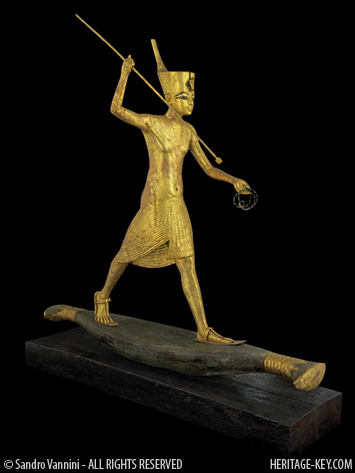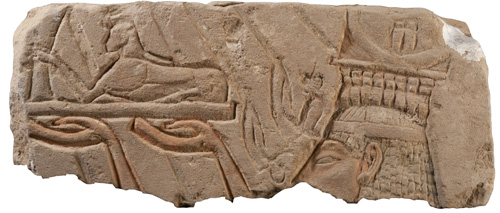 Archaeologists are examining a cache of talatat blocks in Luxor that depict Amarna period art in their original colour.
Archaeologists are examining a cache of talatat blocks in Luxor that depict Amarna period art in their original colour.
“The amount of detail which is shown, where the colour had been preserved, it’s just amazing,” said Dr. Joceyln Gohary.
“Some of the most striking details are in the clothing – particularly of the queen, Nefertiti – details of the dress and jewellery that she’s wearing,” she said.
Dr. Gohary is leading an American Research Center in Egypt (ARCE) project that is documenting, cleaning and conserving them.
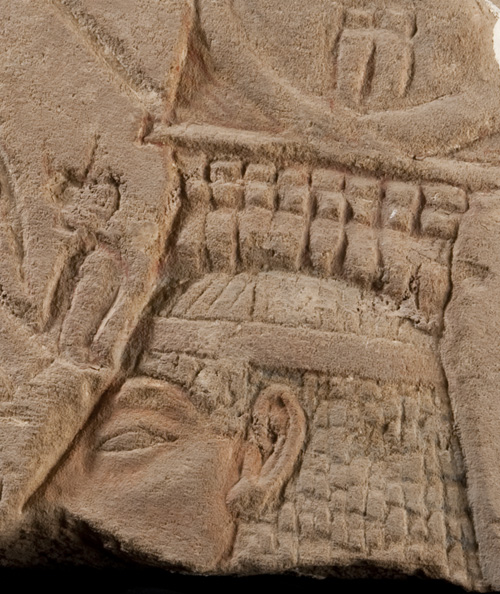 Talatat blocks were used by the pharaoh Akhenaten nearly 3,400 years ago. They were constructed in a standardized size – 55 cm x 25 cm x 25 cm. This standardization probably would have made it easier for temples to be built.
Talatat blocks were used by the pharaoh Akhenaten nearly 3,400 years ago. They were constructed in a standardized size – 55 cm x 25 cm x 25 cm. This standardization probably would have made it easier for temples to be built.
The blocks are in a storage area in Luxor. Almost all of them are decorated. Back in antiquity each block would have been part of a larger scene.
Another key find is that the Aten, the sun disc which the pharaoh Akhenaten focussed Egyptian religion around, radiates light in two colours.
“We have red sun rays and yellow sun rays,” said Gohary. It’s a mystery why the Aten was depicted this way. One idea is that maybe the red sun rays are sunrise or sunset or something like that,” he added.
This find raises the question of whether the sun disc itself was depicted in different colours. “They all seem to be more or less the same shade of red.”
How did the blocks come to Luxor?
How the blocks came to be in a storage area in Luxor is a long story. It’s important to understand that when Akhenaten became pharaoh of Egypt, nearly 3,400 years ago, he brought dramatic changes to his kingdom.
Before he came to power Ancient Egypt was a polytheistic society, with numerous deities. Akhenaten changed this, focussing religion around the worship of one god – the Aten, represented in art by a sun disc with rays.
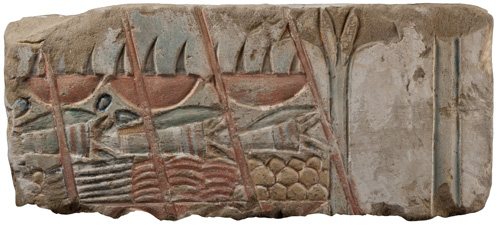 An inscription written about the Aten reads:
An inscription written about the Aten reads:
Beautiful you appear
In the horizon of the sky,
oh living sun,
You have appeared on the eastern horizon
and filled every land with your beauty
You are beautiful, great and shining
high over all the land….
-From Akhenaten and the Religion of Light by Professor Erik Hornung.
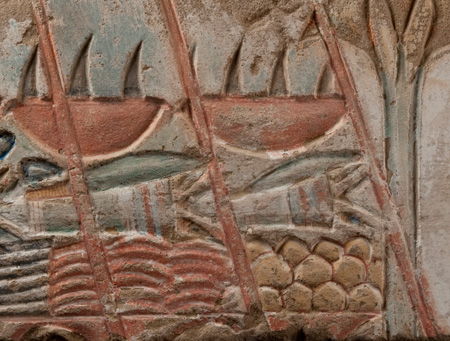 Akhenaten built temples all over Egypt that were devoted to the Aten. He even built a new capital called Akhetaten out in the desert of Middle Egypt.
Akhenaten built temples all over Egypt that were devoted to the Aten. He even built a new capital called Akhetaten out in the desert of Middle Egypt.
Egyptian art changed radically. Human figures, including the pharaoh and his family, were often shown in a grotesque fashion, with long spindly figures, distorted bodies and cone shaped heads. Akhenaten also unleashed an iconoclasm that saw the names of other gods hacked away.
Why art changed this way remains a mystery. One idea is that the pharaoh and his family suffered from a condition, such as Marfan’s syndrome, that affected their physical appearance. That idea was repudiated in a recent analysis of the remains of Akhenaten’s family.
“It is important to note that ancient Egyptian kings typically had themselves and their families represented in an idealized fashion,” wrote Dr. Zahi Hawass and a team of scholars, in the study.
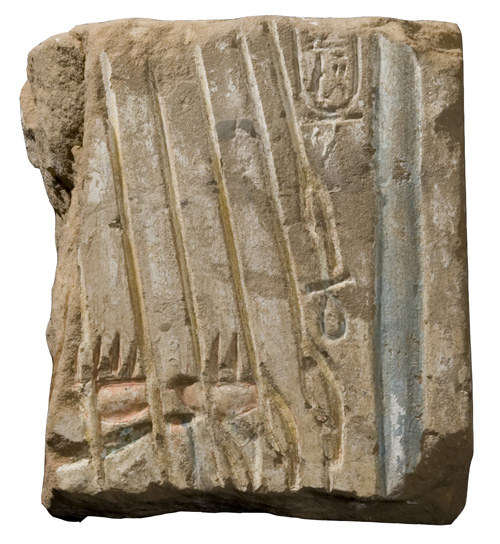 After Akhenaten died his religious system collapsed. The Aten temples were torn down and Egypt returned to being a polytheistic society. Egyptian art went back to normal and Amarna was abandoned.
After Akhenaten died his religious system collapsed. The Aten temples were torn down and Egypt returned to being a polytheistic society. Egyptian art went back to normal and Amarna was abandoned.
“After his death the ancient Egyptians regarded him as a heretic – any temple that he had built around Egypt… were taken down by the Ancient Egyptians,” said Dr. Gohary.
After the temples were torn down, the talatat blocks were re-used in places where they could not be seen easily – such as building foundations and filling inside monumental gateway and pylons.
When archaeologists began work in Luxor and Karnak, back in the 19th century, they began to uncover these blocks.
By the 1960’s over 100,000 had come to light including more than 30,000 decorated ones.
Archaeologists kept the decorated examples, like the blocks Gohary’s team is studying, in roofed magazines, which give them some protection of the elements. Undecorated ones were often kept in open air storage areas.
Preserving the blocks
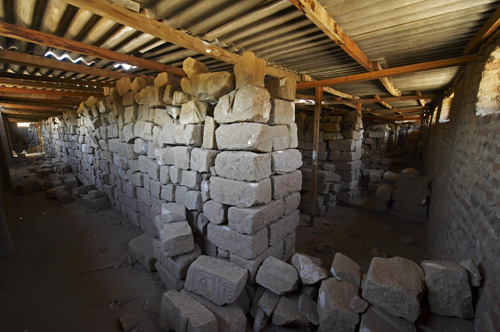 Of the nearly 16,000 blocks that Gohary’s team is studying, few of them have ever been published.
Of the nearly 16,000 blocks that Gohary’s team is studying, few of them have ever been published.
Repairs are being done to the storage area that they are in. When the team arrived they found holes in the roof.
“The roof is still mostly there, there were a few gaps in the roof sheeting, we were able to cover most of these as best we could,” said Dr. Gohary.
Foxes had used the roof holes to enter the storage area and burrow under the stacks of blocks – collapsing nearly 2,000 of them onto the floor. This meant that the team had to fill in the holes and get the talatat back in order. Dust and insects also caused problems since the storage area doesn’t have proper windows – only metal bars.
Still, despite the poor condition of the structure they are in, the talatat blocks are in excellent shape. “Among the 15,000 of them only about five to seven percent were in poor condition,” said Dr. Gohary. “Many of them are still very well decorated and the colours are still very brilliant.”
Nefertiti’s fashion
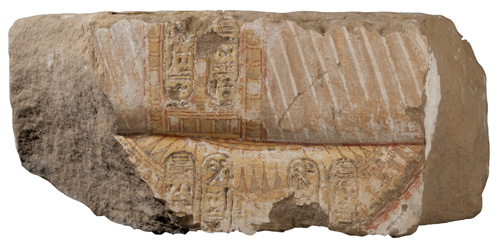 “We seem to have rather more representations of the Queen than the King,” said Dr. Gohary, indicating that some of these blocks came from a temple that had a section dedicated to Nefertiti.
“We seem to have rather more representations of the Queen than the King,” said Dr. Gohary, indicating that some of these blocks came from a temple that had a section dedicated to Nefertiti.
Gohary gave a detailed description as to how these blocks portray the Queen.
In addition to her pleated dress, “she has a red sash which is tied underneath the breasts and then hangs down – the ends of the sash hang down to almost mid-calf length,” she said. “She wears different styles of wigs as well.”
“She wears one which is painted blue,” and “has two long pieces that hangs down – one either side of her face and a longer piece at the back.”
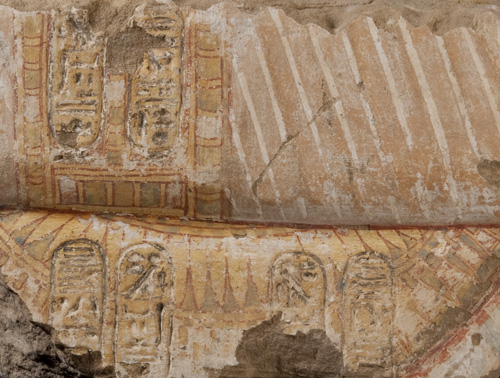 There appear to ringlets or some other accessory attached to it. “Sometimes extended from the end of the long blue wig – at the bottom there – is a cobra – which of course is a symbol of protection for royalty.”
There appear to ringlets or some other accessory attached to it. “Sometimes extended from the end of the long blue wig – at the bottom there – is a cobra – which of course is a symbol of protection for royalty.”
She also occasionally wears what we call a Nubian wig, “(a) much shorter wig which is coloured black, again with ringlets,” said Gohary.
Also “frequently she wears a crown with two very tall feathers, it’s a gold crown with two feathers covered in gold,” said Gohary.
“On her forehead she has a double cobra – which is a type of headdress which is worn by her mother in law – Queen Tiye.”
Gohary pointed out that it’s unusual that there are two cobras on Nefertiti – examples from Amarna show her only wearing one. “This is something perhaps which people in the future will be able to study and find some significance to this.”
Armlets and Bracelets
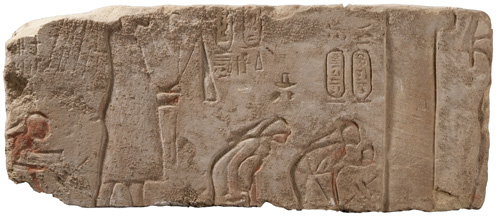 “She wears armlets on her upper arms and bracelets on her wrist, which is usually decorated with the cartouches of the two names of the Aten, the sun disc,” said Dr. Gohary. “The bracelets (are) very brightly coloured, in blue, in green and red, obviously representing gold bracelets which are inlaid with turquoise and carnelian for example.”
“She wears armlets on her upper arms and bracelets on her wrist, which is usually decorated with the cartouches of the two names of the Aten, the sun disc,” said Dr. Gohary. “The bracelets (are) very brightly coloured, in blue, in green and red, obviously representing gold bracelets which are inlaid with turquoise and carnelian for example.”
Nefertiti’s daughters are depicted a bit differently.
“What is interesting about the princess, that accompanies the Queen, (is) she also wears bracelets but hers are not decorated with the names of the gods,” she said. “It’s only the King and Queen that have them decorated that way.”
Publication
The team is working on a database that contains all the images and documentation, as well as the archival material that is available. They hope to produce a book that will discuss and illustrate their discoveries. There are also tentative plans to create a website that scholars can use to analyze the findings.
“It hasn’t been decided in exactly what form this will eventually be available online,” said Dr. Gohary.
So now, nearly 3,400 years after they were used as fill by Akhenaten’s successors, the pharaoh’s artwork is set to be re-introduced to the world.




